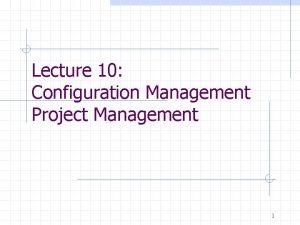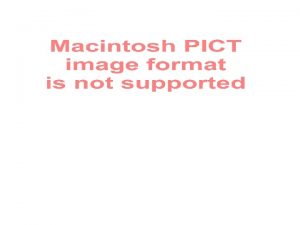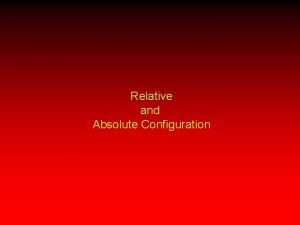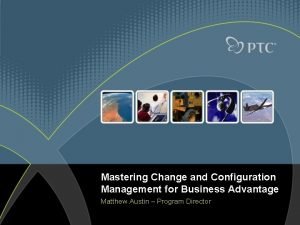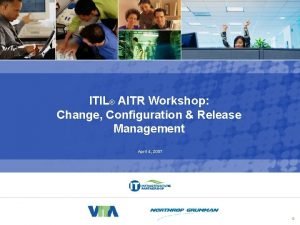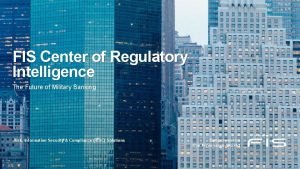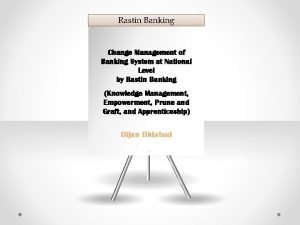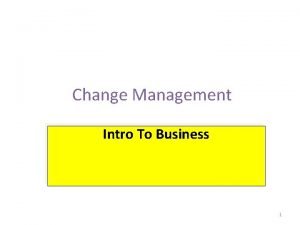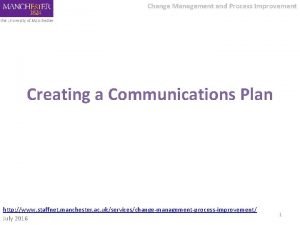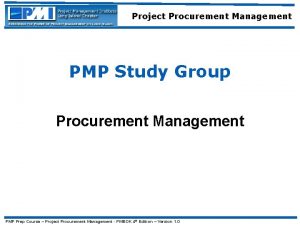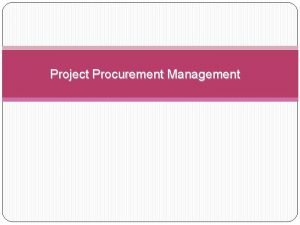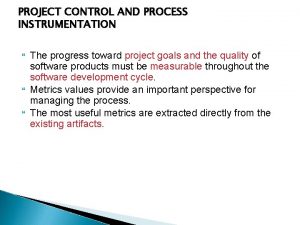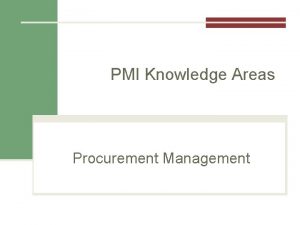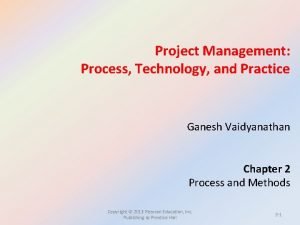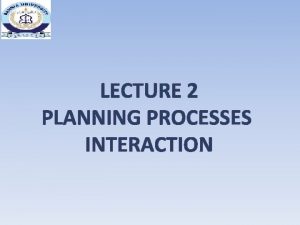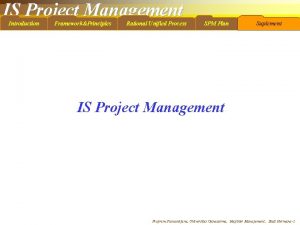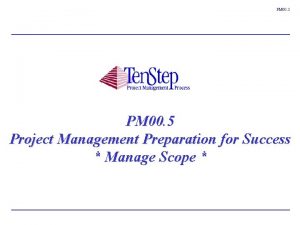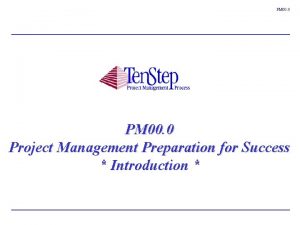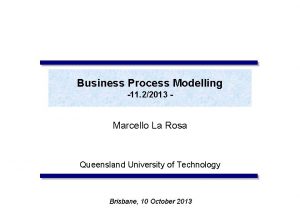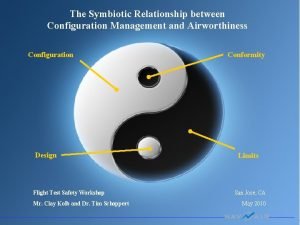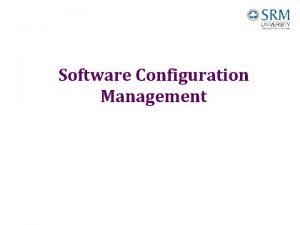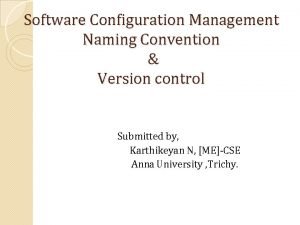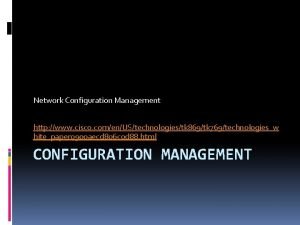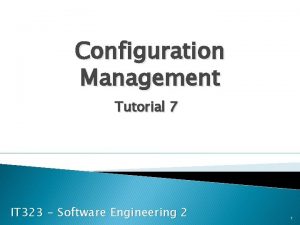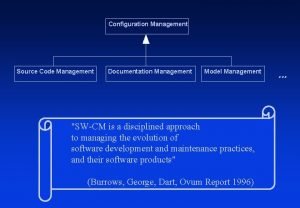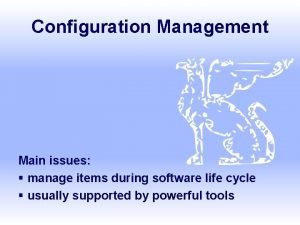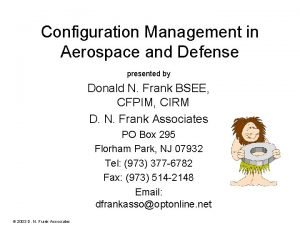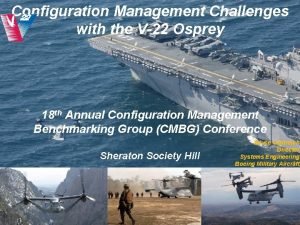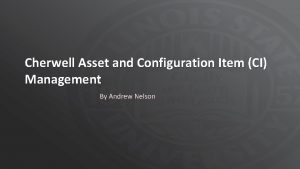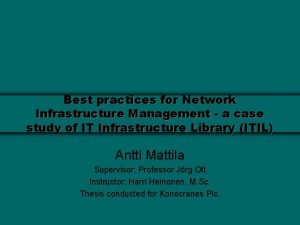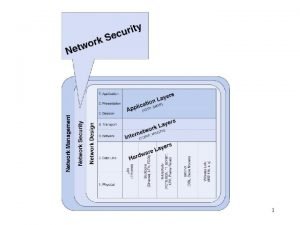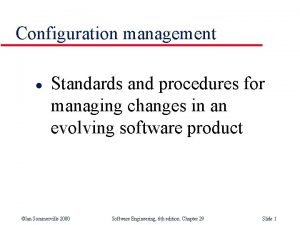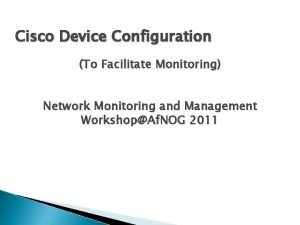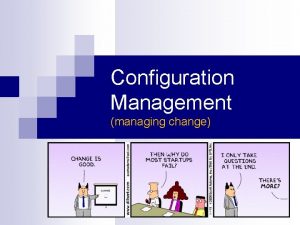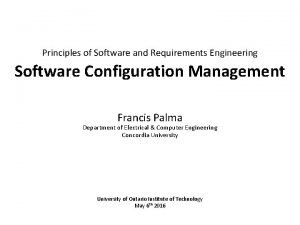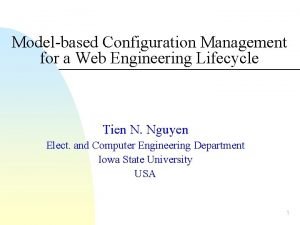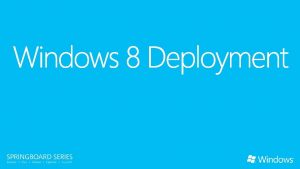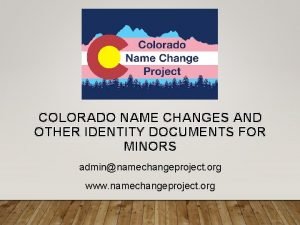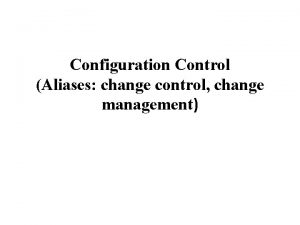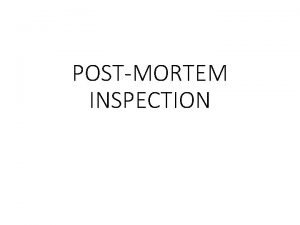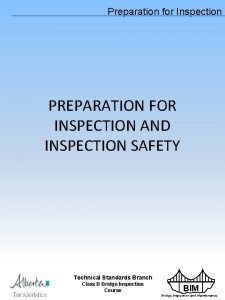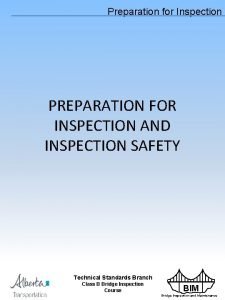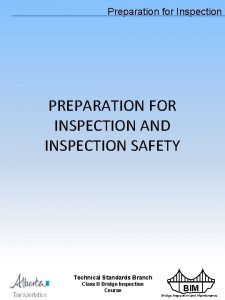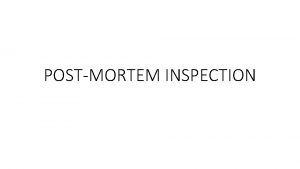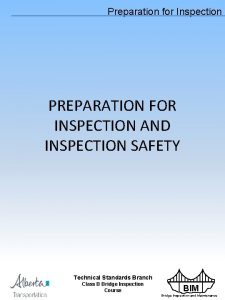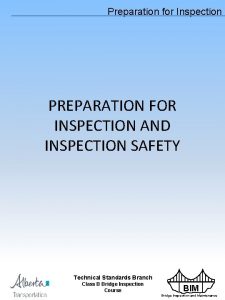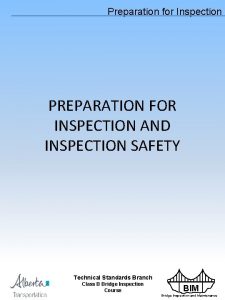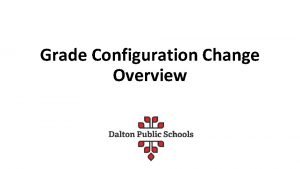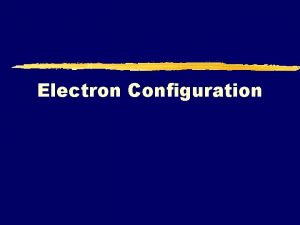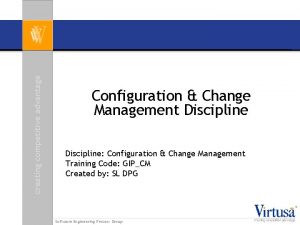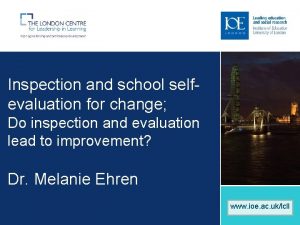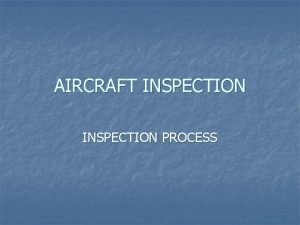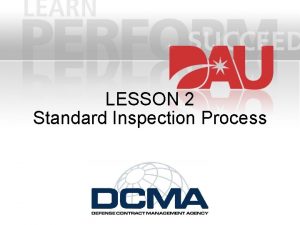Project management Inspection Configuration management Change management Process













































































- Slides: 77

Project management Inspection Configuration management Change management Process management OTHER SOFTWARE PROCESSES Other Processes 1

Other Processes Development Process is the central process around which others revolve Methods for other processes often influenced by the dev process We have looked at various models for dev process a “real” process likely derived from a model Other Processes 2

Other Processes In the context of Dev Processes Other Processes 3

Other Processes Project management process Inspection process Configuration management process Change management process Process management process Will briefly look at these now Other Processes 4

PROJECT MANAGEMENT PROCESS Other Processes 5

The Typical PMs Role Overall responsibility for the successful planning, execution, monitoring, control and closure of a project. Primary point of contact with project sponsors Key tasks Plans Meets Communicates Project Management == Leadership Other Processes 6

10 Qualities of a PM 1. Inspires a Shared Vision 2. Good Communicator 3. Integrity 4. Enthusiasm 5. Empathy 6. Competence 7. Ability to Delegate Tasks 8. Cool Under Pressure 9. Team-Building Skills 10. Problem Solving Skills Other Processes 7

What does a PM do? Development process divides development into phases and activities To execute it efficiently, must allocate resources, manage them, monitor progress, take corrective actions, … These are all part of the PM process Hence, PM process is an essential part of executing a project Other Processes 8

PM Process Phases There are three broad phases Before: Planning During �Monitoring and control �Communication facilitation After: Postmortem analysis Planning is a key activity that produces a plan, which forms the basis of monitoring Other Processes 9

Project Management Concerns Other Processes 10

Project Management Tools Other Processes 11

Planning Done before project begins Key tasks Cost and schedule estimation Staffing Monitoring and risk mgmt plans Quality assurance plans Etc. Will discuss planning in detail later Other Processes 12

Monitoring and control Lasts for the duration of the project and covers the development process Monitors all key parameters like cost, schedule, risks Takes corrective actions when needed Needs information on the dev process – provided by metrics Other Processes 13

Communication Facilitation Realistically no plan covers everything! Additional decisions are made during development Documents should be updated and communicated Typical environment Multiple teams Multiple user groups Multiple disciplines Multiple locations In many setting PM is center of communication hub Will discuss in more detail later Other Processes 14

Meeting Types Project Planning Meetings Review of progress against schedule Update plan, identify pain points and dependencies Publically call team leads to task Content Meetings Regular meetings focused around content topics E. G. “Reporting”, “Backend API” Make decision, Record them, Communicate them Use of the “Rolling Email” Other Processes 15

Meeting Types Issues Meetings Regularly schedule meeting (ie. open in everyone’s schedule) Issues gathered the day before and distributed Issue initiator indicates required attendance QA Meetings Planning �Discussion with business �Discussion with developers Regular Review of open tickets Other Processes 16

Meeting Modalities In person Video Conference Voice Conference Shared Desktop + Voice Conference Pros/Cons of each? Other Processes 17

Postmortem Analysis Postmortem analysis is performed when the development process is over Basic purpose: to analyze the performance of the process, and identify lessons learned Improve predictability and repeatability Central to a “Learning Organization” or culture Also called termination analysis Other Processes 18

Relationship with Dev Process Other Processes 19

Risk Management From “Keep Your Projects On Track” http: //www. drdobbs. com/184414727 PROJECT MANAGEMENT PROCESS Other Processes 20

Risk Management Usually performed 1. at the start of a project, 2. at the beginning of major project phases (such as requirements, design, coding and deployment), and 3. when there are significant changes (for example, feature changes, target platform changes and technology changes). Other Processes 21

Risk Management Four steps to risk management are 1. risk identification, 2. risk analysis, 3. risk management planning and 4. risk review Other Processes 22

1) Risk Identification the brainstorming session, consider : Weak areas, such as unknown technology. Aspects that are critical to project success, such as the timely delivery of a vendor's database software, creation of translators or a user interface that meets the customer's needs. Problems that have plagued past projects, such as loss of key staff, missed deadlines or error-prone software Other Processes 23

1) Risk Identification Collect up the stakeholder! Who? Hold a brainstorming session, consider : Weak areas, such as unknown technology. Aspects that are critical to project success, such as the timely delivery of a vendor's database software, creation of translators or a user interface that meets the customer's needs. Problems that have plagued past projects, such as loss of key staff, missed deadlines or errorprone software Other Processes 24

2) Risk Analysis Make each risk item more specific. Risks like "Lack of management buy-in" and "People might leave" are too vague. Split the risk into smaller, specific risks, such as "Manager Jane could decide the project isn't beneficial, " "The database expert might leave, " and "The webmaster may be pulled off the project. “ Set priorities Other Processes 25

2) Risk Analysis Risk Items (Potential Future Problems Likelihood of Impact to Priority Derived from Brainstorming) Risk Item Project if Risk (Likelihood * Occurring Item Does Occur Impact) New operating system may be unstable. 10 10 100 Communication problems over system 8 issues. We may not have the right requirements 9 9 72 6 54 Requirements may change late in the cycle. Database software may arrive late. 7 7 49 4 8 32 Key people might leave. 2 10 20 Other Processes 26

3) Risk Management Planning Risk Items (Potential Future Problems Derived from Brainstorming) Actions to Reduce Likelihood Actions to Who Should Reduce Impact if Work on Risk Does Occur Actions New operating system may not be stable. Test OS more. Identify second OS. Communica-tion problems over system issues. Develop system interface document for critical interfaces. We may not have the right requirements. Build prototype Limit Initial of UI. product distribution Add replan milestone to realign the team's schedule with other areas. When Should Actions Be Complete Status of Actions Joe 3/3/01 Cathy 5/6/01 Lois 4/6/01 Other Processes 27

4) Risk Review review your risks periodically, check how well mitigation is progressing. change risk priorities, as required Identify new risks. rerun the complete risk process if the project has experienced significant changes. incorporate risk review into other regularly scheduled project reviews Other Processes 28

Risk Management Time Effective! 90 to 120 minutes for projects that are 12 to 60 person-months Control the length of the session by controlling the scope you choose, most sessions usually take less than two hours Other Processes 29

Communication Facilitation THE PROJECT MANAGEMENT PROCESS Other Processes 30

Meeting Types Project Planning Meetings Review of progress against schedule Update plan, identify pain points and dependencies Publically call team leads to task Content Meetings Regular meetings focused around content topics E. G. “Reporting”, “Backend API” Make decision, Record them, Communicate them Use of the “Rolling Email” Other Processes 31

Meeting Types Issues Meetings Regularly schedule meeting (ie. open in everyone’s schedule) Issues gathered the day before and distributed Issue initiator indicates required attendance QA Meetings Planning �Discussion with business �Discussion with developers Regular Review of open tickets Other Processes 32

Meeting Modalities In person Video Conference Voice Conference Shared Desktop + Voice Conference Pros/Cons of each? Other Processes 33

Face to Face Communication A verbal message is affected by: The message itself Paralingual attributes of the message (ie. the pitch, tone, and inflections in the speaker's voice) Nonverbal communication (ie. Posture, facial expression, shoulders, tugging on the ears, crossed arms, hand signals) To be an effective communicator, you must ask questions. Do you understand me? Questions help the project team, ask for clarification, and achieve an exact transfer of knowledge. Other Processes 34

Writing Email 1) Understand why you’re writing have explicit answers for two questions: Why am I writing this? What exactly do I want the result of this message to be? Other Processes 35

Writing Email 2) Get what you need Really just three basic types of business email. �Providing information - “Larry Tate will be in the office Monday at 10. ” �Requesting information - “Where did you put the ‘Larry Tate’ file? ” �Requesting action - “Will you call Larry Tate’s admin to confirm our meeting on Monday? ” The recipient must immediately know which type of email it is. Other Processes 36

Writing Email 3) Make One Point per Email If you need to communicate a number of different things: Consider writing a separate email on each subject, especially if they related to different topics or have different timescales. Consider presenting each point in a separate, numbered paragraph, especially if relate to the same project. Making each point stand out, significantly increasing the likelihood that each point will be addressed. Other Processes 37

Writing Email 3) Write a great Subject line Help your recipient to immediately understand why you’ve sent them an email quickly determine what kind of response or action it requires Avoid “Hi, ” “One more thing…, ” or “FYI, ” Best is a short summary of the most important points Lunch resched to Friday @ 1 pm Reminder: Monday is "St. Bono’s Day"–no classes REQ: Resend Larry Tate zip file? HELP: I’ve lost the source code? Thanks for the new liver–works great! Other Processes 38

Writing Email 3) Brevity is the soul of…getting a response The Long Crafted Email: 1% �Explores nuances �Handling political hot potatoes The Short Directed Email: 99% �Make it fit on one screen with no scrolling. �Better still in the “review space” �A concise email is much more likely to get action But be presise… Other Processes 39

Bad Example Subject: Proposal Lynn, Did you get my proposal last week? I haven't heard back and wanted to make sure. Can you please call me so we can discuss? Thanks! Peter Good Example Subject: Checking On Reliable Landscapes Proposal Lynn, I just wanted to check that you have received the landscaping proposal I emailed to you last week. I haven't heard back and wanted to make sure it went through. Can you please call me by Thursday so we can discuss? This is when our discount offer expires, and I want to make sure you don't miss it! The quickest way to contact me is by cell phone. Thanks! Peter Schuell, Owner Reliable Landscaping, Inc. 555. 135. 4598 (office) 555. 135. 2929 (cell) Other Processes 40

THE INSPECTION PROCESS Other Processes 41

Background Main goal of inspection process is to detect defects in work products First proposed by Fagan in 70 s Earlier used for code, now used for all types of work products Is recognized as an industry best practice Data suggests that it improves both Q&P http: //en. wikipedia. org/wiki/Fagan_inspection Other Processes 42

Background “A defect is an instance in which a requirement is not satisfied. ” [Fagan, 1986] Defects injected in sw at any stage Hence must remove them at every stage Inspections can be done on any document including design docs and plans Is a good method for early phases like requirements and design Also useful for plans (PM plans, CM plans, testing plans, …) Other Processes 43

Some Characteristics Conducted by group of technical people for technical people (i. e. review done by peers) Is a structured process with defined roles for the participants The focus is on identifying problems, not resolving them Review data is recorded and used for monitoring the effectiveness Other Processes 44

Steps in Typical Review Process Other Processes 45

Planning Select the group review team – three to five people group is best Identify the moderator – has the main responsibility for the inspection Prepare package for distribution – work product for review plus supporting docs Package should be complete for review Other Processes 46

Overview and Self-Review A brief meeting – deliver package, explain purpose of the review, intro, … All team members then individually review the work product Lists the issues/problems they find in the selfpreparation log Checklists, guidelines are used Ideally, should be done in one sitting and issues recorded in a log Other Processes 47

Self-Review Log Project name: Work product name and ID: Reviewer Name: Effort spent (hours): Defect list No Location Description Criticality Other Processes 48

Group Review Meeting Purpose – define the final defect list Entry criteria each member has done a proper self-review logs are reviewed Group review meeting A reviewer goes over the product line by line At any line, all issues are raised Discussion follows to identify if a defect Decision recorded (by the scribe) Other Processes 49

Group Review Meeting… At the end of the meeting Scribe presents the list of defects/issues If few defects, the work product is accepted; else it might be asked for another review Group does not propose solutions �though some suggestions may be recorded A summary of the inspections is prepared �useful for evaluating effectiveness Other Processes 50

Group Review Meeting… Moderator is in-charge of the meeting and plays a central role Ensures that focus is on defect detection and solutions are not discussed/proposed Work product is reviewed, not the author of the work product Amicable/orderly execution of the meeting Uses summary report to analyze the overall effectiveness of the review Other Processes 51

Summary Report Example Project Work Product Type Size of work product Review team Effort (person hours) Preparation Group meeting Total XXXX Project plan 14 pages P 1, P 2, P 3 10 (total) 10 20 Other Processes 52

Summary Contd. Defects No of critical defects No of major defects No of minor defects Total Review status Reco for next phase Comments 0 3 16 19 Accepted Nil Nice plan Other Processes 53

Rework and Follow Up Defects in the defects list are fixed later by the author Once fixed, author gets it OKed by the moderator, or goes for another review Once all defects/issues are satisfactorily addressed, review is completed and collected data is submitted Other Processes 54

Roles and Responsibilities Main roles Moderator – overall responsibility Author –Listen, inform, avoid defensiveness Reviewer(s) – to identify defects Reader – not there in some processes, reads line by line to keep focus Scribe – records the issues raised Other Processes 55

Guidelines for Work Products Work Product Inspection focus Participants Req Spec Meet customer needs Are implementable Omissions, inconsistencies, ambiguities Customer Designer Tester, Dev Analyst HLD Design implements req Design is implementable Ommissions, quality of design Req author Designer Developer Other Processes 56

Guidelines for Work Products Code implements design Code is complete and correct Defects in code Other quality issues Designer Tester Developer Test cases Set of test cases test all SRS conditions Test cases are executable Are perf and load tests there Req author Tester Proj mgr Proj Mgmt Plan is complete and specifies all components of the plan Is implementable Omissions and ambiguities Proj mgr Another Proj mgr Other Processes 57

Summary Purpose of reviews: to detect defects Structured reviews are very effective - can detect most of the injected defects For effective review, process has to be properly defined and followed Data must be collected analyzed Other Processes 58

CONFIGURATION MANAGEMENT PROCESS Other Processes 59

Background A software project produces many items - programs, documents, data, manuals, … All of these can be changed easily – need to keep track state of items Software Configuration Management (SCM) Systematically control the changes Focus on changes during normal evolution (req changes will be handled separately) CM requires discipline as well as tools Other Processes 60

Background SCM often independent of dev process Dev process looks at macro picture, but not on changes to individual items/files As items are produced during dev they are brought under SCM controls only the products of the development process Other Processes 61

SCM Process and Dev process Other Processes 62

Need for CM needed to deliver product to the client What files should comprise the product? What versions of these files? How to combine these to make the product? Just for this, versioning is needed, and state of different items has to be tracked There are other functions of CM also Other Processes 63

Functionality Needed Capture current state of programs Capture latest version of a program Undo a change and revert back to a specified version Prevent unauthorized changes Gather all sources, documents, and other information for the current system Other Processes 64

CM Mechanisms Configuration identification and baselining Version control Access control These are the main mechanisms, there are others like naming conventions, directory structure, … Other Processes 65

Configuration Items Sw consists of many items/artifacts In CM some identified items are placed under CM control Changes to these are then tracked Periodically, system is built using these items and baselines are established Baseline – logical state of the system and all its items; is a reference point Other Processes 66

Version and access control Key issues in CM Done primarily on source code through source code control systems, which also provide access control Allows older versions to be preserved and hence can undo changes Examples: CVS – Original open source system (1986) Subversion – Open source CVS replacement (1999) Microsoft Visual Source. Safe (VSS) – targeted for smaller dev projects IBM Rational Clear. Case – Industrial strength solution Other Processes 67

Version and Access Control When programmer developing code – is in private area When code is made available to others, it goes in an access-controlled library For making changes to an item in library, it has to be checked out Changes made by checking-in the item – versioning is automatically done Final system is built from the library Other Processes 68

Version/Access Control Generally both version and access control done through CM tools Tools limit access to specified people - formal check in, check out procedures Automatic versioning done when a changed file is checked-in Check-in, check-out control may be restricted to a few people in a project Require successful compile/build cycle Other Processes 69

CM Process Defines the activities for controlling changes Main phases CM Planning Executing the CM process CM audits Other Processes 70

CM Planning Identify items to be placed under CM Define library structure for CM Define change control procedures Define access control, baselining, reconciliation, procedures Define release procedure Other Processes 71

CM Audit During project execution CM procedures have to be followed (e. g. moving items between directories, naming, following change procedures, …) Process audit has to be done CM audit can also check if items are where they should be Other Processes 72

Summary – CM is about managing the different items in the product, and changes in them Developing a CM plan at the start is the key to successful to CM procedures have to be followed; audits have to be performed Requires discipline and tools Other Processes 73

REQUIREMENTS CHANGE MANAGEMENT PROCESS Other Processes 74

Background Requirements change at any time during the development Changes impact the work products and the various configuration items Uncontrolled changes can have a huge adverse impact on project in cost/sched Changes have to be allowed, but in a controlled manner Other Processes 75

A Change Mgmt Process Log the changes Perform impact analysis on the work products and items Estimate impact on effort and schedule Review impact with stakeholders Rework the work products/items Other Processes 76

Changes Change often triggered by change request Change req log keeps a record of requests Impact analysis for a change request involves identifying the changes needed to diff items, and the nature of change The impact of changes on the project is reviewed to decide whether to go ahead Cumulative changes also often tracked Other Processes 77
 Configuration management system pmp
Configuration management system pmp Configuration management definition
Configuration management definition Relative configuration vs absolute configuration
Relative configuration vs absolute configuration Chiral or achiral
Chiral or achiral Electron configuration vs noble gas configuration
Electron configuration vs noble gas configuration Absolute configuration vs relative configuration
Absolute configuration vs relative configuration Windchill configuration management
Windchill configuration management Change configuration & release management
Change configuration & release management Traditional project management vs modern project management
Traditional project management vs modern project management Distinguish between process control and product control
Distinguish between process control and product control Gmp inspection process
Gmp inspection process Regulatory change management process
Regulatory change management process Change management process maturity model
Change management process maturity model Hr role in change management process
Hr role in change management process Change management process in banking sector
Change management process in banking sector Change management process
Change management process Change management process
Change management process The role of project management in achieving project success
The role of project management in achieving project success Modern project profiles in spm
Modern project profiles in spm Cost duration graph
Cost duration graph Introduction to project management kathy schwalbe
Introduction to project management kathy schwalbe Software project evaluation
Software project evaluation Types of project audit in project management
Types of project audit in project management Ms project agile planning
Ms project agile planning Types of terminations
Types of terminations Is mashing potatoes a chemical change
Is mashing potatoes a chemical change Physical vs chemical change examples
Physical vs chemical change examples Absolute change and relative change formula
Absolute change and relative change formula Two negative integers
Two negative integers Whats the difference between physical and chemical changes
Whats the difference between physical and chemical changes Difference between supply and quantity supplied
Difference between supply and quantity supplied Change in supply and change in quantity supplied
Change in supply and change in quantity supplied Change your water change your life
Change your water change your life Proactive vs reactive change
Proactive vs reactive change Physical change and chemical change
Physical change and chemical change Spare change physical versus chemical change
Spare change physical versus chemical change Rocks change due to temperature and pressure change
Rocks change due to temperature and pressure change Physical change and chemical change venn diagram
Physical change and chemical change venn diagram Physical change
Physical change Which is an example of a physical change
Which is an example of a physical change First-order change
First-order change Chopping wood is a physical change
Chopping wood is a physical change Climate change 2014 mitigation of climate change
Climate change 2014 mitigation of climate change Project procurement management process
Project procurement management process Project procurement management process
Project procurement management process Mtbf and maturity
Mtbf and maturity Procurement management pmi
Procurement management pmi Intake process for project demand management
Intake process for project demand management Project management process group and knowledge area mapping
Project management process group and knowledge area mapping Project management process technology and practice
Project management process technology and practice What is portfolio management process
What is portfolio management process Interaction planning process
Interaction planning process Rational unified process project management
Rational unified process project management Ten step project management process
Ten step project management process Ten step project management
Ten step project management Business process levels
Business process levels Aircraft configuration management
Aircraft configuration management Scm control enables team to
Scm control enables team to Software configuration management version control
Software configuration management version control Cisco network configuration manager
Cisco network configuration manager Configuration management tutorial
Configuration management tutorial Source code configuration management
Source code configuration management Configuration management challenges
Configuration management challenges Aerospace configuration management
Aerospace configuration management Bruce oestreich
Bruce oestreich Itemcı
Itemcı Change management network infrastructure
Change management network infrastructure Performance and configuration management
Performance and configuration management Software configuration management basics and standards
Software configuration management basics and standards Cisco device configuration management
Cisco device configuration management Edward bersoff
Edward bersoff Configuration management questions
Configuration management questions How to copy picture on mac
How to copy picture on mac Configuration management for web engineering
Configuration management for web engineering Configuration management challenges
Configuration management challenges Jira project lead
Jira project lead Colorado name change project
Colorado name change project Project eddie climate change
Project eddie climate change
